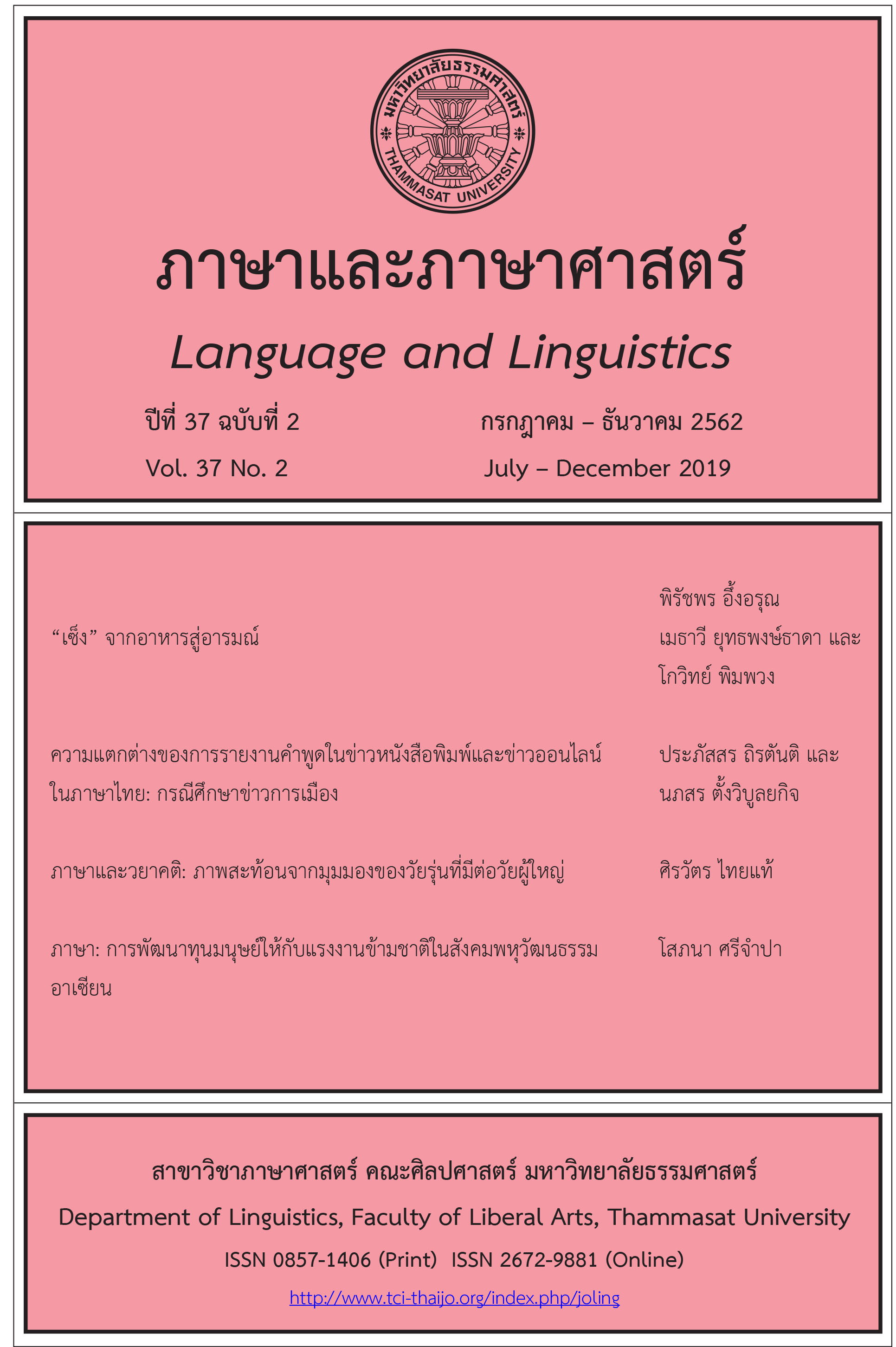Difference between Speech Presentations of News Reports in Newspapers and Online News in Thai: A Case Study of Political News
Main Article Content
Abstract
Speech presentation, which is the process of reporting antecedent speech in a new context, is one of the significant elements in news articles. Based on the assumption that different news channels can affect the use of speech presentation, this study aims to investigate the difference between speech presentations used in newspapers and online news, and to compare the faithfulness of the reported speech with the original speech. The data were collected from political news across three platforms: news articles in newspapers, online news, and original speech from interview clips. The results show that the reporters chose the method of speech presentation differently depending on their judgment. They might employ the same kind of presentation across channels, but vary the words used. Also, they can apply different means of the presentation in newspapers and online news, which definitely alters details of the speech presented. In terms of faithfulness, it was found that the reporters do not always use the presentation in accordance with its definition. The findings display the use of direct speech with summarized content and the use of indirect speech that is reported verbatim. The difference in speech presentation has an influence on the readers’ understanding
Article Details
บทความทุกบทความเป็นลิขสิทธิ์ของภาษาและภาษาศาสตร์
References
กรุงเทพมหานครและปริมณฑล (รายงานการวิจัย). กรุงเทพฯ: มหาวิทยาลัยหอการค้าไทย.
นิตย์สุดา อภินันทาภรณ์. (2534). ลักษณะการเชื่อมโยงในการรายงานข่าวสารอาชญากรรมของหนังสือพิมพ์ไทยรัฐ: การศึกษาภาษา
ระดับข้อความ (วิทยานิพนธ์ปริญญามหาบัณฑิต). มหาวิทยาลัยธรรมศาสตร์, กรุงเทพฯ.
นริสรา คูสุวรรณ. (2550). ความสัมพันธ์ระหว่างการจัดหน้าหนึ่งของหนังสือพิมพ์และหนังสือพิมพ์ออนไลน์และการรับรู้ลำดับความ
สำคัญของข่าวและการเลือกเปิดรับข่าว (วิทยานิพนธ์ปริญญามหาบัณฑิต). จุฬาลงกรณ์มหาวิทยาลัย, กรุงเทพฯ.
พิษณุรักษ์ ปิตาทะสังข์. (2548). การเล่าเรื่องและการสร้างความจริงทางสังคมในข่าวคลื่นยักษ์สึนามิ (วิทยานิพนธ์ปริญญามหา
บัณฑิต). จุฬาลงกรณ์มหาวิทยาลัย, กรุงเทพฯ.
สำนักงานพัฒนาธุรกรรมทางอิเล็กทรอนิกส์. (2561). ETDA เปิดพฤติกรรมผู้ใช้อินเทอร์เน็ตปี 61 คนไทยใช้เน็ตเพิ่ม 10 ชั่วโมง 5 นาที
ต่อวัน. สืบค้นจาก https://www.etda.or.th/content/etda-reveals-thailand-internet-user-profile-2018.html
อดิสา วงศ์ลักษณพันธ์. (2542). การเล่าเรื่องในข่าวการเมืองของหนังสือพิมพ์ไทย (วิทยานิพนธ์ปริญญามหาบัณฑิต). จุฬาลงกรณ์
มหาวิทยาลัย, กรุงเทพฯ.
Abdulla, R. A., Garrison, B., Salwen, M., Driscoll, P., & Casey, D. (2002). The credibility of newspapers, television news,
and online news. Paper Presented to the Mass Communication and Society Division, Association for Education in
Journalism and Mass Communication, Annual Convention, Miami, FL.
Archer, D., Aijmer, K., & Wichmann, A. (2012). Pragmatics: An advanced resource book for students. London, England:
Routledge.
Banfield, A. (1973). Narrative style and the grammar of direct and indirect speech. Foundations of Language, 10(1), 1-
39.
Bardoel, J., & Deuze, M. (2001). ‘Network journalism’: Converging competencies of old and new media professionals.
Australian Journalism Review, 23(2), 91-103.
Boczkowski, P. J., & de Santos, M. (2007). When more media equals less news: Patterns of content homogenization in
Argentina's leading print and online newspapers. Political Communication, 24(2), 167-180.
Cappon, R. J. (1991). Associated press guide to news writing. New York, NY: Arco.
Carter, R. F., & Greenberg, B. S. (1965). Newspapers or television: Which do you believe?. Journalism Quarterly, 42(1),
29–34.
Djenar, D. N., Ewing, M. C., & Manns, H. (2018). Style and intersubjectivity in youth interaction. Boston, MA: De
Gruyter.
Finberg, H., & Stone, M. L. (2002). Digital journalism credibility study. Wasington, DC: Online News Association.
Ghersetti, M. (2014). Still the same? Comparing news content in online and print media. Journalism Practice, 8(4), 373-
389.
Gidengil, E., & Everitt, J. (2003). Talking tough: Gender and reported speech in campaign news coverage. Political
Communication, 20(3), 209-232.
Harry, J. C. (2014). Journalistic quotation: Reported speech in newspapers from a semiotic-linguistic perspective.
Journalism, 15(8), 1041-1058.
Hoffman, L. H. (2006). Is internet content different after all? A content analysis of mobilizing information in online and
print newspapers. Journalism & Mass Communication Quarterly, 83(1), 58-76.
Karlsson, M. (2011). The immediacy of online news, the visibility of journalistic processes and a restructuring of
journalistic authority. Journalism, 12(3), 279-295.
Kim, D., & Johnson, T. J. (2009). A shift in media credibility: Comparing internet and traditional news sources in South
Korea. International Communication Gazette, 71(4), 283-302.
Leech, G., & Short, M. (1981). Style in fiction. London, England: Pearson.
Maier, S. (2010). ‘All the news fit to post? Comparing news content on the web to newspapers, television, and radio.
Journalism & Mass Communication Quarterly, 87(3-4), 548-562.
Mitchelstein, E., & Boczkowski, P. J. (2009). Between tradition and change: A review of recent research on online news
production. Journalism, 10(5), 562-586.
O’Keeffe, A., Clancy, B., & Adlophs, S. (2011). Introducing pragmatics in use. London, England: Routledge.
Pavlik, J. V. (1996). New media technology: Cultural and commercial perspectives. Boston, MA: Allyn and Bacon.
Quandt, T. (2008). (NO) news on the world wide web? A comparative content analysis of online news in Europe and
the United States. Journalism Studies, 9(5), 717-738.
Redeker, G. (1996). Free indirect discourse in newspaper reports. In C. Cremers & M. den Dikken (Eds.), Linguistics in
the Netherlands 1996 (pp. 221-232). Amsterdam, Netherlands: John Benjamins.
Rimmer, T., & Weaver, D. (1987). Different questions, different answers? Media use and media credibility. Journalism
Quarterly, 64(1): 28–44.
Schegloff, E. A., Jefferson, G., & Sacks, H. (1977). The preference for self-correction in the organization of repair in
conversation. Language, 53(2), 361-382.
Semino, E., & Short, M. (2004). Corpus stylistics: Speech, writing and thought presentation in a corpus of English
writing. London, England: Routledge.
Short, M. (2012). Discourse presentation and speech (and writing, but not thought) summary. Language and Literature,
21(1), 18-32.
Tiratanti, P., & Durongbhan, P. (2019). Speech presentation model for Thai news reports. Manuscript submitted for
publication.
Tucher, A. (1997). Why web warriors might worry. Columbia Journalism Review, 36(2), 35–39.
van der Wurff, R., & Lauf, E. (2005). Print and online newspapers in Europe: A comparative analysis in 16 countries.
Amsterdam, Netherlands: Het Spinhuis.
Waugh, L. R. (1995). Reported speech in journalistic discourse: The relation of function and text. Text-Interdisciplinary
Journal for the Study of Discourse, 15(1), 129-173.
Wunsch-Vincent, S., & Vickery, G. (2009). Working party on the information economy: The evolution of news and the
internet (Research Report). Paris, France: Organization for Economic Co-operation and Development.


